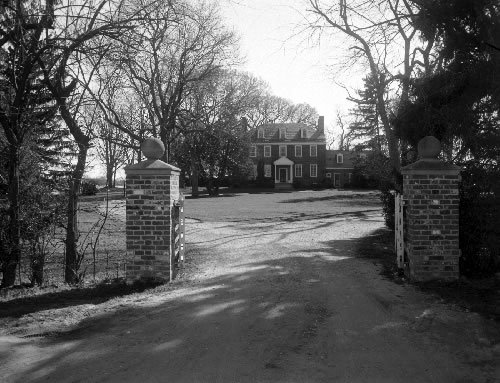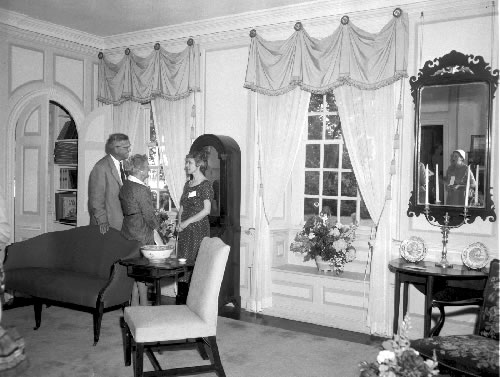“The committee has ascertained that the sashes which were taken from the windows of the State House by Governor Carroll were bought by the late R.C. Holliday [sic] and sent by him to his farm near Easton. Mr. Mayer has written to Senator Charles H. Gibson, who now has the farm to ask him whether the sashes are still there and whether one of them can be procured for a pattern.”
 |
| Ratcliffe Manor, circa 1950s. Pusey Collection, Talbot County Free Library. |
Shortly after Hollyday’s death in 1885, his wife, Marietta, remarried Senator Charles H. Gibson, which accounts for why he was the recipient of Mayer’s inquiry. In 1905, Marietta sold Ratcliffe Manor to A.A. Hathaway of Wisconsin who occupied the house until 1917, when it changed hands to the McCoy family and was sold again to the Smith family in the 1940s. From descriptions of the house dating from the 1940-1960s, it can be inferred that the house had not undergone any major restoration efforts since it had been built and much of the original material is still intact.
 |
| Drawing Room, Ratcliffe Manor, circa 1950s. Pusey Collection, Talbot County Free Library. |
 |
| Drawing Room, Ratcliffe Manor. Image courtesy of Sasha Lourie, MSA, 2012. |
The majority of the windows in the house are 18th century and feature a 12-over-12 design, like the original windows in the State House. Unfortunately, the State House windows are not present at Ratcliffe, and it seems unlikely that they were ever part of the main house. Mrs. Harrington indicated that there were no other buildings on the property that could accommodate windows of the size that were removed from the State House. She and her husband have owned the house since the mid-1990s, and they have not seen any caches of architectural elements on the property.
.jpg) |
| Sasha Lourie and Hope Harrington in front of Ratcliffe Manor. Image courtesy of Hayley Jenkins, MSA, 2012. |
The windows, like many other pieces of the original Old Senate Chamber, were salvaged by patriotic citizens during the 1876 renovation of the space. If you have any information about material original to the Maryland State House please contact the Maryland State Archives. See our CONTACT section or email: elaine.bachmann@maryland.gov.
Why is it called Ratcliffe Manor?
ReplyDelete